Geometric and Material Modelling Aspects for Strength Prediction of Riveted Joints
Abstract
:1. Introduction
2. Experiments on Riveted Joints
2.1. Rivet Joint Configuration
2.2. Experimental Results
2.3. Plate and Rivet Material
3. Finite Element Modelling
3.1. Material Model
3.2. Contact Interaction and Boundary Conditions
3.3. Pre-Load in Rivets
4. Validation of FEA Modelling Framework
5. Application to Industrial Component
5.1. Results of Joining Methods
5.2. Re-Design of the Riveted Joint
6. Conclusions
Supplementary Materials
Author Contributions
Funding
Institutional Review Board Statement
Informed Consent Statement
Data Availability Statement
Conflicts of Interest
Nomenclature
| c | Configuration of plates |
| d | Rivet shank diameter |
| dmat | Damage in material |
| E | Young’s modulus |
| E’ | Diminished Young’s modulus |
| Fu | Ultimate strength |
| Fe | Conventional elastic strength |
| Fmax | Force equal to 80% of the ultimate strength after the peak load |
| lb | Bottom rivet head height |
| le | Characteristic length |
| lg | Gauge length |
| ls | Rivet shank length |
| lt | Top rivet head height |
| n | Number of rivets |
| N | Hardening exponent |
| p | Pitch between rivets |
| r | Rivet distance from plate edge |
| SN | Specimen number |
| t | Plate thickness |
| upl | Plastic equivalent displacement |
| ufpl | Plastic equivalent displacement at fracture |
| w | Plate width |
| α | Rivet head angle |
| δ | Displacement |
| δu | Displacement corresponding to ultimate strength |
| δe | Displacement corresponding to elastic strength |
| δmax | Displacement corresponding to force equal to 80% of ultimate strength |
| Δ | Displacement-controlled loading |
| ε | Strain |
| ε0 | Initial yield strain |
| εN | Normalizing strain |
| εS | Offset strain |
| Strain rate | |
| Equivalent plastic strain at onset of fracture | |
| σ0 | Yield strength |
| σFEA | Pressure applied on rivet heads |
| σut | Ultimate strength |
| Experimental true stress following softening response | |
| ξ | Normalized length of rivet shank |
References
- Koç, M.; Allen, T.; Jiratheranat, S.; Altan, T. Use of FEA and design of experiments to establish design guidelines for simple hydroformed parts. Int. J. Mach. Tools Manuf. 2000, 40, 2249–2266. [Google Scholar] [CrossRef]
- Khurshid, M.; Barsoum, Z.; Barsoum, I. Load carrying capacities of butt welded joints in high strength steels. J. Eng. Mater. Technol. 2015, 137, 041003. [Google Scholar] [CrossRef]
- Nassiraei, H.; Mojtahedi, A.; Lotfollahi-Yaghin, M.A. Static strength of X-joints reinforced with collar plates subjected to brace tensile loading. Ocean Eng. 2018, 161, 227–241. [Google Scholar] [CrossRef]
- Baha II, S.; Klapp, O.; Hesebeck, O. Simulation of the solid rivet installation process. SAE Int. J. Aerosp. 2010, 3, 187–197. [Google Scholar] [CrossRef]
- Chen, N.; Ducloux, R.; Pecquet, C.; Malrieux, J.; Thonnerieux, M.; Wan, M.; Chenot, J.-L. Numerical and experimental studies of the riveting process. Int. J. Mater. Form. 2011, 4, 45–54. [Google Scholar] [CrossRef]
- Li, G.; Shi, G.; Bellinger, N.C. Residual stress/strain in three-row, countersunk, riveted lap joints. J. Aircr. 2007, 44, 1275–1285. [Google Scholar] [CrossRef]
- Rans, C.; Straznicky, P.V.; Alderliesten, R. Riveting process induced residual stresses around solid rivets in mechanical joints. J. Aircr. 2007, 44, 323–329. [Google Scholar] [CrossRef]
- Zhao, J.; Peng, Y.; Su, W.; Dong, J. Finite element analysis of the shear capacity of stainless-steel blind-rivet connections. J. Constr. Steel Res. 2021, 179, 106558. [Google Scholar] [CrossRef]
- Vivio, F.; Fanelli, P.; Ferracci, M. Experimental characterization and numerical simulation of riveted lap-shear joints using Rivet Element. Int. J. Adv. Struct. Eng. 2018, 10, 37–47. [Google Scholar] [CrossRef] [Green Version]
- Bedair, O.K.; Eastaugh, G.F. A numerical model for analysis of riveted splice joints accounting for secondary bending and plates/rivet interaction. Thin-Walled Struct. 2007, 45, 251–258. [Google Scholar] [CrossRef]
- Kumar, D.V.T.G.P.; Naarayan, S.S.; Sundaram, S.K.; Chandra, S. Further numerical and experimental failure studies on single and multi-row riveted lap joints. Eng. Fail. Anal. 2012, 20, 9–24. [Google Scholar] [CrossRef]
- Belardi, V.G.; Fanelli, P.; Vivio, F. Theoretical definition of a new custom finite element for structural modeling of composite bolted joints. Compos. Struct. 2021, 258, 113199. [Google Scholar] [CrossRef]
- Sire, S.; Mayorga, L.G.; Plu, B. Observation of Failure Scenarios in Riveted Assemblies: An Innovative Experimental Strategy. Procedia Eng. 2015, 114, 430–436. [Google Scholar] [CrossRef]
- Al-bahkali, E. Finite Element Modeling for Thermal Stresses Developed in Riveted and Rivet-Bonded Joints. Int. J. Eng. 2011, 11, 86–92. [Google Scholar]
- Leonetti, D.; Maljaars, J.; Pasquarelli, G.; Brando, G. Rivet clamping force of as-built hot-riveted connections in steel bridges. J. Constr. Steel Res. 2020, 167, 105955. [Google Scholar] [CrossRef]
- Stevens, R.T.; Sherman, R.J.; Hebdon, M.H. Correlating Surface Hardness to Shear Strength of Driven Rivets and Distribution of In Situ Rivet Hardness. J. Mater. Civ. Eng. 2021, 33, 04020476. [Google Scholar] [CrossRef]
- Lepretre, E.; Chataigner, S.; Dieng, L.; Gaillet, L.; Cannard, H. Numerical and experimental investigations of hot driven riveting process on old metal structures. Eng. Struct. 2016, 127, 583–593. [Google Scholar] [CrossRef]
- Pipinato, A.; Molinari, M.; Pellegrino, C.; Bursi, O.S.; Modena, C. Fatigue tests on riveted steel elements taken from a railway bridge. Struct. Infrastruct. Eng. 2011, 7, 907–920. [Google Scholar] [CrossRef]
- Larsson, T. Fatigue Assessment of Riveted Railway Bridges. Ph.D. Thesis, Luleå University of Technology, Luleå, Sweden, 2009. [Google Scholar]
- Xu, W.; Wang, D. Material–Structure–Process–Performance Integration Multi-Objective Optimization Design for Solid Rivet Joint. J. Mater. Eng. Perform. 2021, 30, 5541–5556. [Google Scholar] [CrossRef]
- Silva, L.F.M.; Gonçalves, J.P.M.; Oliveira, F.M.F.; De Castro, P.M.S.T. Multiple-site damage in riveted lap-joints: Experimental simulation and finite element prediction. Int. J. Fatigue 2000, 22, 319–338. [Google Scholar] [CrossRef]
- Amiri, M. Fatigue Life Prediction of Rivet Joints. J. Fail. Anal. Prev. 2019, 19, 1844–1852. [Google Scholar] [CrossRef]
- Maljaars, J.; Leonetti, D.; Maas, C. Fatigue life prediction of hot riveted double covered butt joints. Int. J. Fatigue 2019, 124, 99–112. [Google Scholar] [CrossRef]
- Leonetti, D.; Maljaars, J.; Snijder, H.H. Fatigue life prediction of hot-riveted shear connections using system reliability. Eng. Struct. 2018, 186, 471–483. [Google Scholar] [CrossRef]
- Fuiorea, I.; Bartis, D.; Nedelcu, R.; Mocanu, A. The Rivet Parameter Influence in Fatigue Strength. Fatigue Aircr. Struct. 2009, 2009, 50–57. [Google Scholar] [CrossRef] [Green Version]
- Baghous, N.; Barsoum, I. Effect of Material Strength on Ductile Failure of Steel in Pressure Vessel Design. J. Press. Vessel Technol. 2021, 143, 021503. [Google Scholar] [CrossRef]
- D’Aniello, M.; Portioli, F.; Fiorino, L.; Landolfo, R. Experimental investigation on shear behaviour of riveted connections in steel structures. Eng. Struct. 2011, 33, 516–531. [Google Scholar] [CrossRef]
- Zhu, J.; Khurshid, M.; Barsoum, I.; Barsoum, Z. Computational weld-mechanics assessment of welding distortions in a large beam structure. Eng. Struct. 2021, 236, 112055. [Google Scholar] [CrossRef]
- Bhatti, A.A.; Barsoum, Z.; Khurshid, M. Development of a finite element simulation framework for the prediction of residual stresses in large welded structures. Comput. Struct. 2014, 133, 1–11. [Google Scholar] [CrossRef]
- Maalouf, M.; Barsoum, Z. Failure strength prediction of aluminum spot-welded joints using kernel ridge regression. Int. J. Adv. Manuf. Technol. 2017, 91, 3717–3725. [Google Scholar] [CrossRef]
- Milone, A.; D’Aniello, M.; Landolfo, R. Influence of camming imperfections on the resistance of lap shear riveted connections. J. Constr. Steel Res. 2023, 203, 107833. [Google Scholar] [CrossRef]
- Siahaan, R.; Keerthan, P.; Mahendran, M. Finite element modeling of rivet fastened rectangular hollow flange channel beams subject to local buckling. Eng. Struct. 2016, 126, 311–327. [Google Scholar] [CrossRef] [Green Version]
- Hanssen, A.G.; Olovsson, L.; Porcaro, R.; Langseth, M. A large-scale finite element point-connector model for self-piercing rivet connections. Eur. J. Mech. A/Solids 2010, 29, 484–495. [Google Scholar] [CrossRef]
- Kim, C.; Min, K.M.; Choi, H.; Kim, H.J.; Lee, M.G. Development of analytical strength estimator for self-piercing rivet joints through observation of finite element simulations. Int. J. Mech. Sci. 2021, 202, 106499. [Google Scholar] [CrossRef]
- Vivio, F. A new theoretical approach for structural modelling of riveted and spot welded multi-spot structures. Int. J. Solids Struct. 2009, 46, 4006–4024. [Google Scholar] [CrossRef]
- Dassault Systèmes. Abaqus/Explicit. 2021. Available online: https://www.3ds.com/products-services/simulia/products/abaqus/abaqusexplicit/ (accessed on 22 February 2023).
- Barsoum, I.; Khalaf, A.M. Evaluation of a pipe-flange connection method based on cold work. J. Press. Vessel Technol. 2015, 137, 061407. [Google Scholar] [CrossRef]
- Hooputra, H.; Gese, H.; Dell, H.; Werner, H. A comprehensive failure model for crashworthiness simulation of aluminium extrusions. Int. J. Crashworthiness 2004, 9, 449–464. [Google Scholar] [CrossRef]
- Dassault Systèmes. About Damage and Failure for Ductile Metals. Available online: https://abaqus-docs.mit.edu/2017/English/SIMACAEMATRefMap/simamat-c-damageductile.htm#simamat-c-damageductile-t-DamageEvolution-sma-topic2 (accessed on 8 October 2021).
- Hillerborg, A.; Modéer, M.; Petersson, P.E. Analysis of crack formation and crack growth in concrete by means of fracture mechanics and finite elements. Cem. Concr. Res. 1976, 6, 773–781. [Google Scholar] [CrossRef]
- Dassault Systèmes. Damage Evolution and Element Removal for Ductile Metals. Available online: https://abaqus-docs.mit.edu/2017/English/SIMACAEMATRefMap/simamat-c-damageevolductile.htm#simamat-c-damageevolductile-t-DefiningDamageEvolutionBasedOnEffectivePlasticDisplacement-sma-topic4 (accessed on 7 July 2021).
- Budynas, R.G.; Nisbett, J.K. Shigley’s Mechanical Engineering Design, 10th ed.; McGraw Hill: New York, NY, USA, 2015. [Google Scholar]
- Khurshid, M.; Meurling, L. Evolution of Scientific Methods for Structural Life Assessment and Its Application on Lightweight Spreader Design. No. 1–9 February 2021. Available online: https://bromma.com/bromma-white-paper-evolution-of-scientific-methods-and-designing-lightweight-spreader/ (accessed on 26 April 2022).
- Zhu, J.; Khurshid, M.; Barsoum, Z. Accuracy of computational welding mechanics methods for estimation of angular distortion and residual stresses. Weld. World 2019, 63, 1391–1405. [Google Scholar] [CrossRef] [Green Version]
- Kuether, R.J.; Allen, M.S.; Hollkamp, J.J. Modal substructuring of geometrically nonlinear finite element models with interface reduction. AIAA J. 2017, 55, 1695–1706. [Google Scholar] [CrossRef]
- Khurshid, M.; Barsoum, Z.; Mumtaz, N.A. Ultimate strength and failure modes for fillet welds in high strength steels. Mater. Des. 2012, 40, 36–42. [Google Scholar] [CrossRef]
- Khurshid, M.; Leitner, M.; Barsoum, Z.; Schneider, C. Residual stress state induced by high frequency mechanical impact treatment in different steel grades—Numerical and experimental study. Int. J. Mech. Sci. 2017, 123, 34–42. [Google Scholar] [CrossRef]
- EN1993-1-8; Eurocode 3: Design of Steel Structures—Part 1–8: Design of Joints. The European Union: Brussels, Belgium, 2005.
- Sedlacek, G.; Kammel, C.; Kühn, W.H.B. Condition Assessment and Inspection of Steel Railway Bridges, Including Stress Measurements in Riveted, Bolted and Welded Structures. Sustainable Bridges—Assessment for Future Traffic Demands and Longer Lives. 2007. pp. 1–94. Available online: http://www.diva-portal.org/smash/record.jsf?pid=diva2%3A1337394&dswid=3747 (accessed on 26 April 2022).
- Maraveas, C.; Fasoulakis, Z.C.; Tsavdaridis, K.D. Mechanical properties of High and Very High Steel at elevated temperatures and after cooling down. Fire Sci. Rev. 2017, 6, 3. [Google Scholar] [CrossRef] [Green Version]


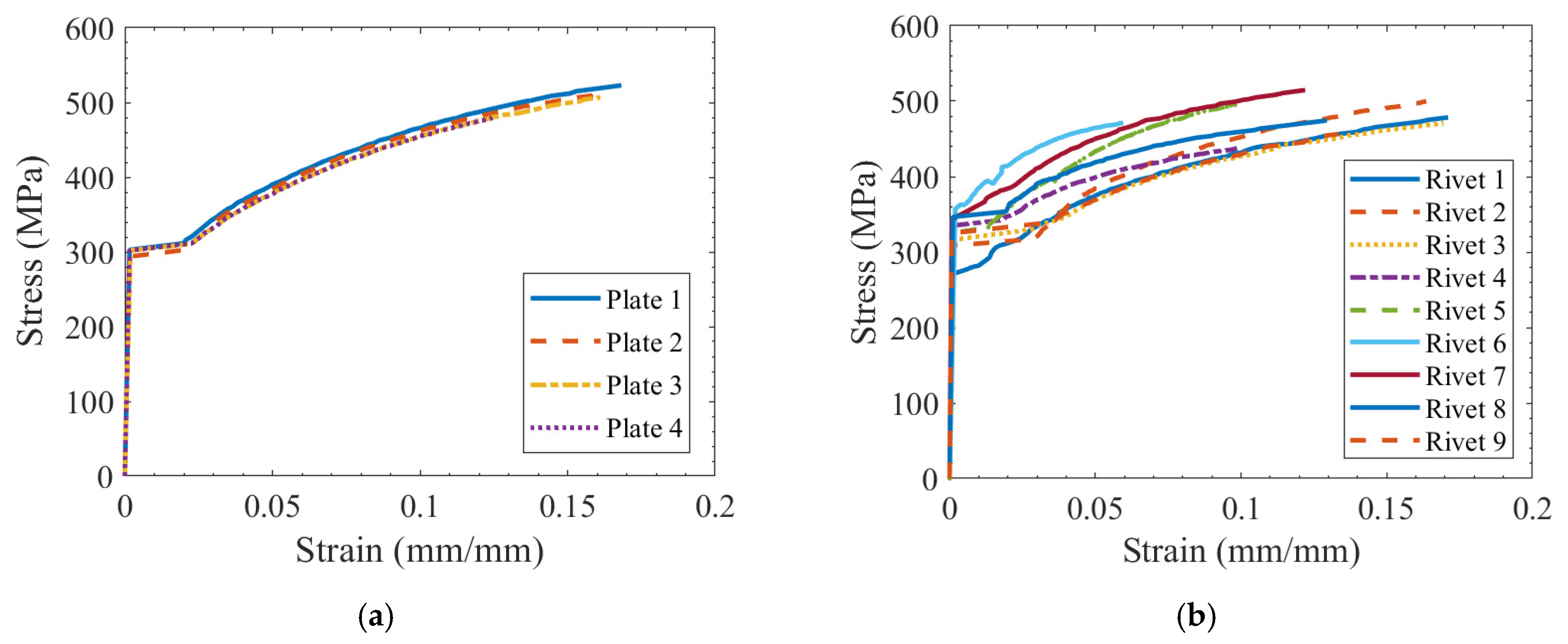

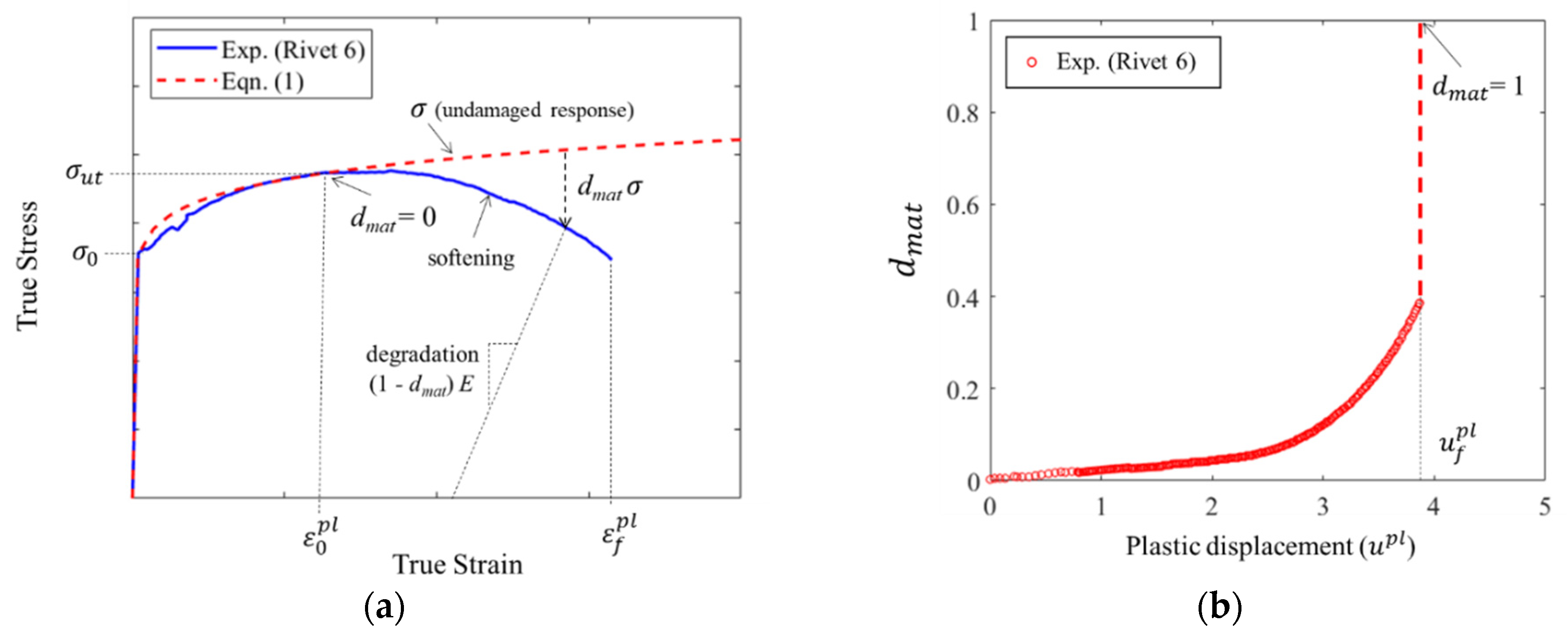
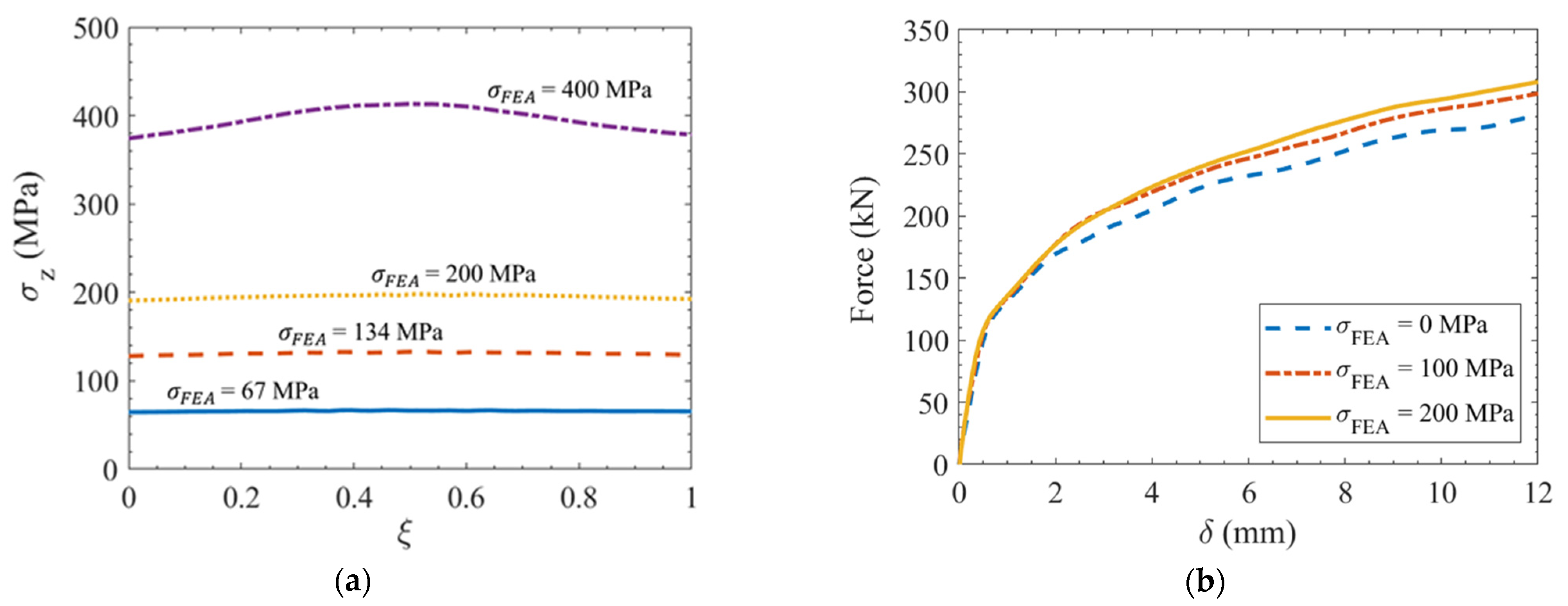
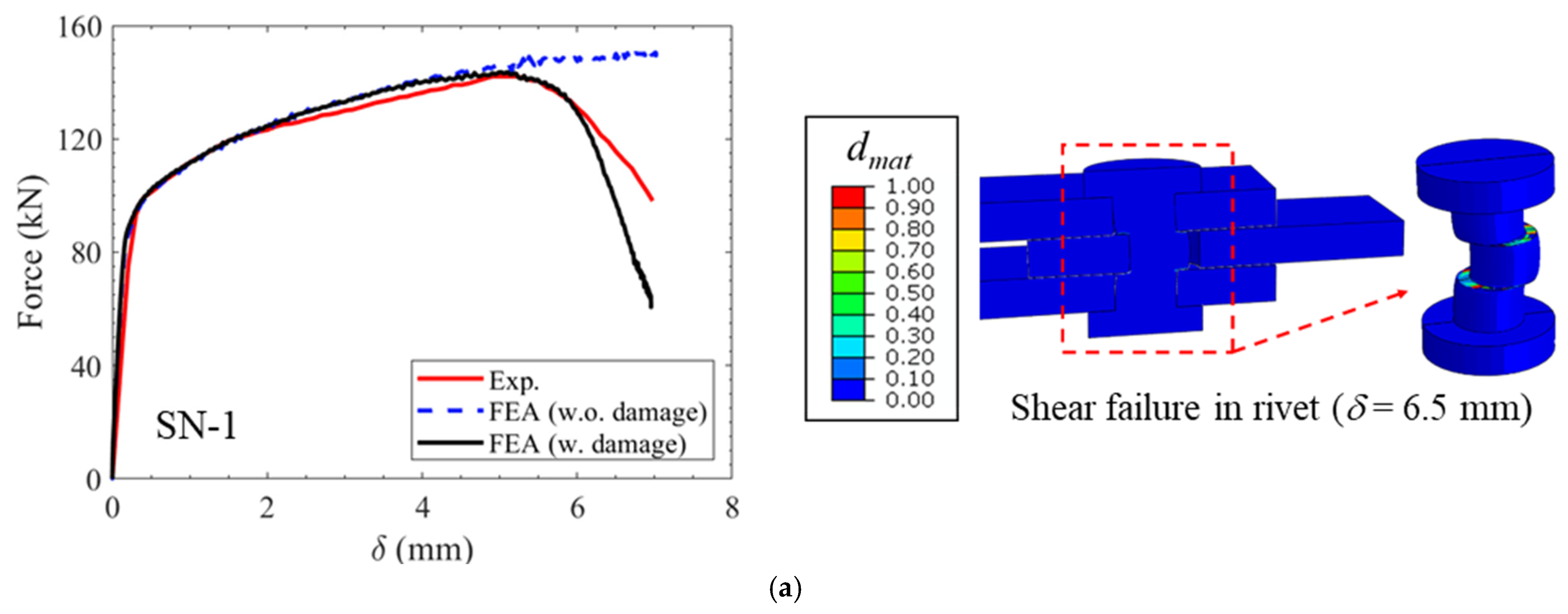
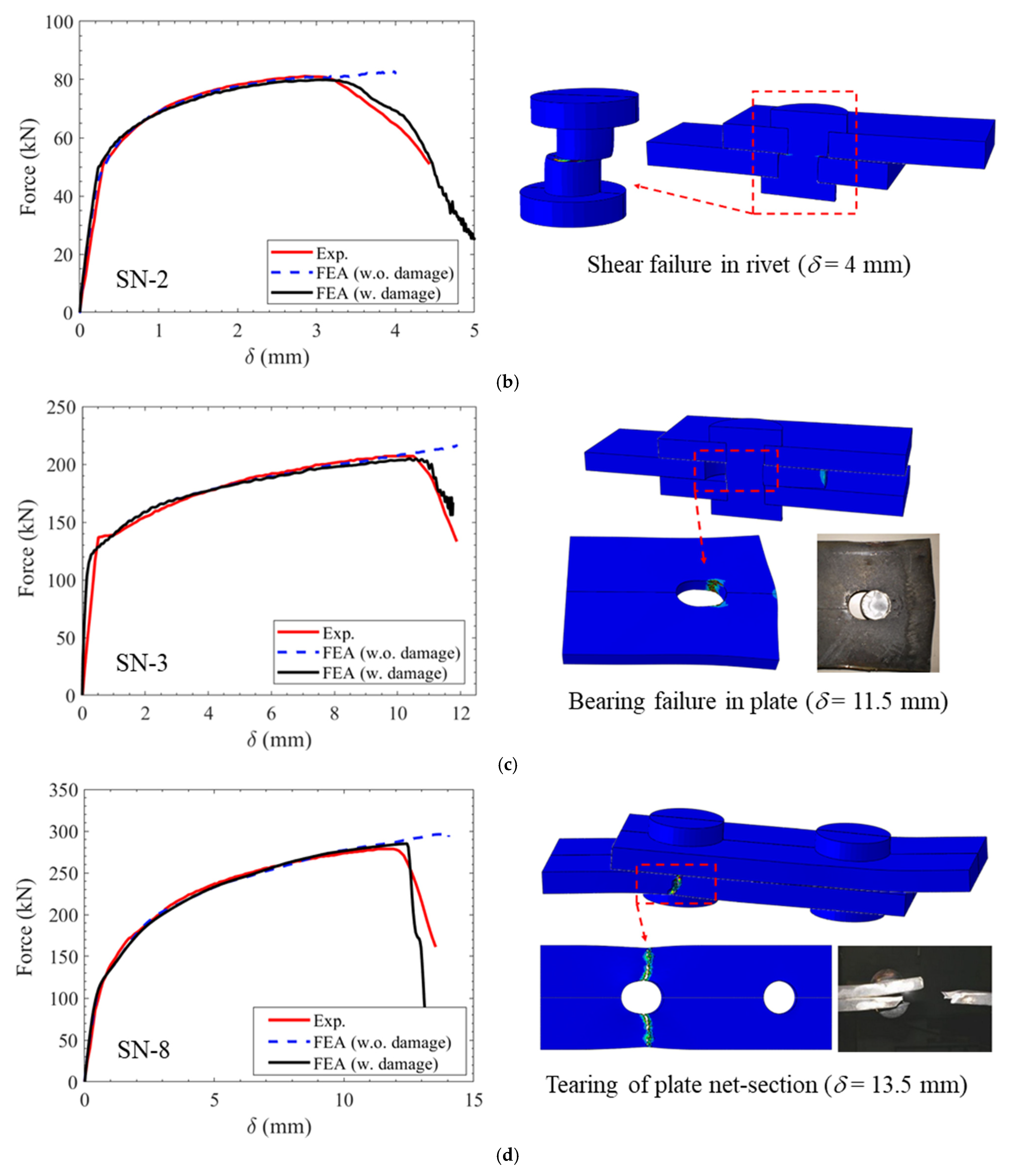
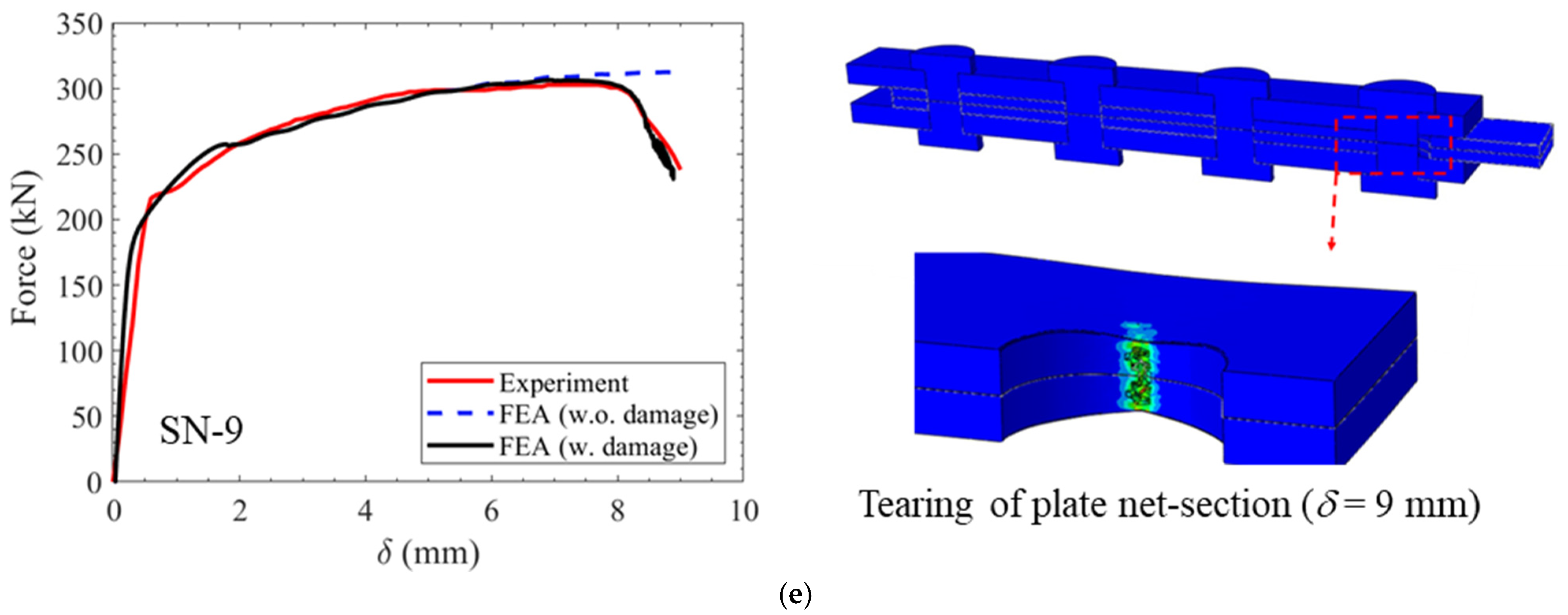
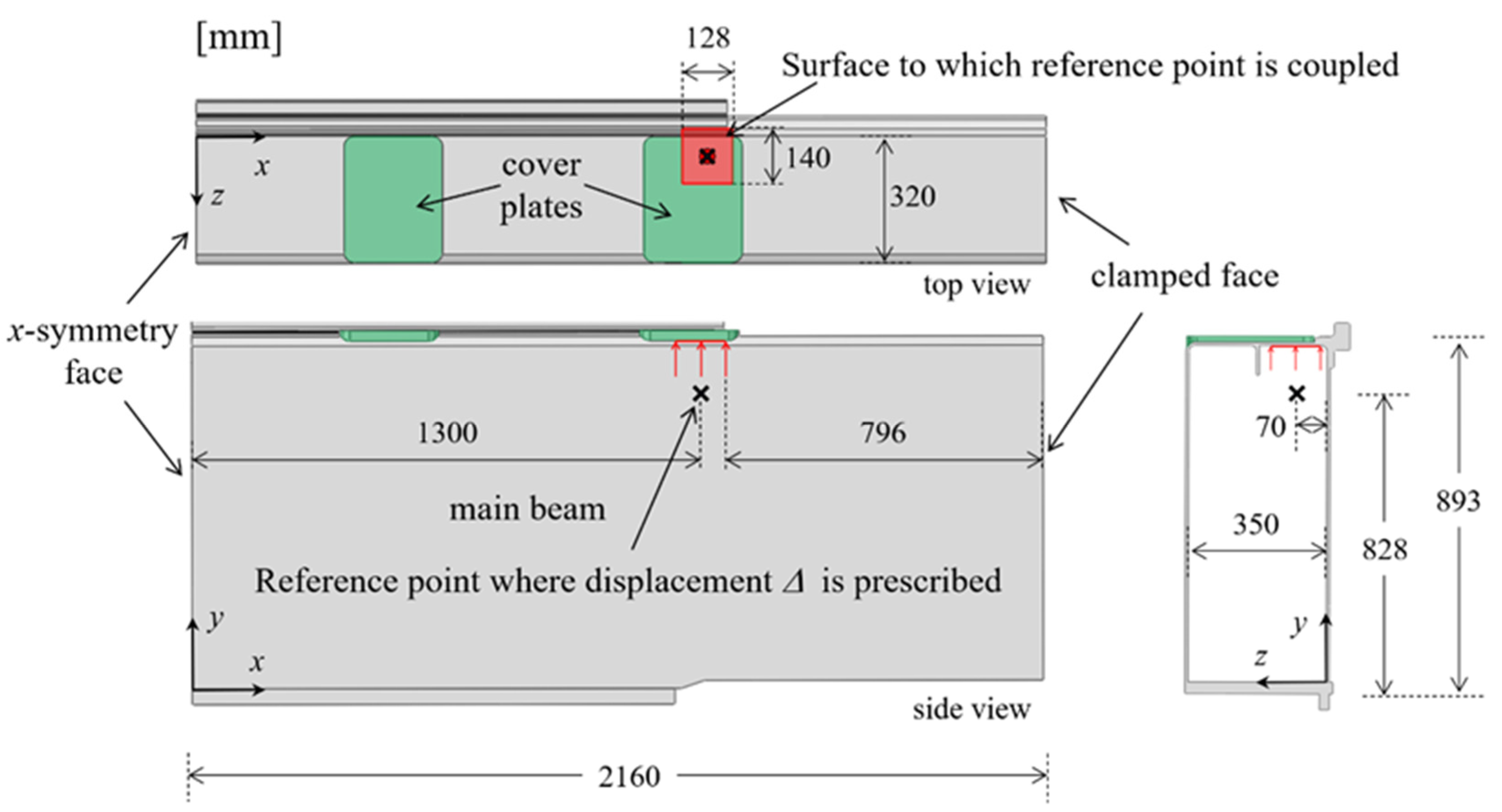
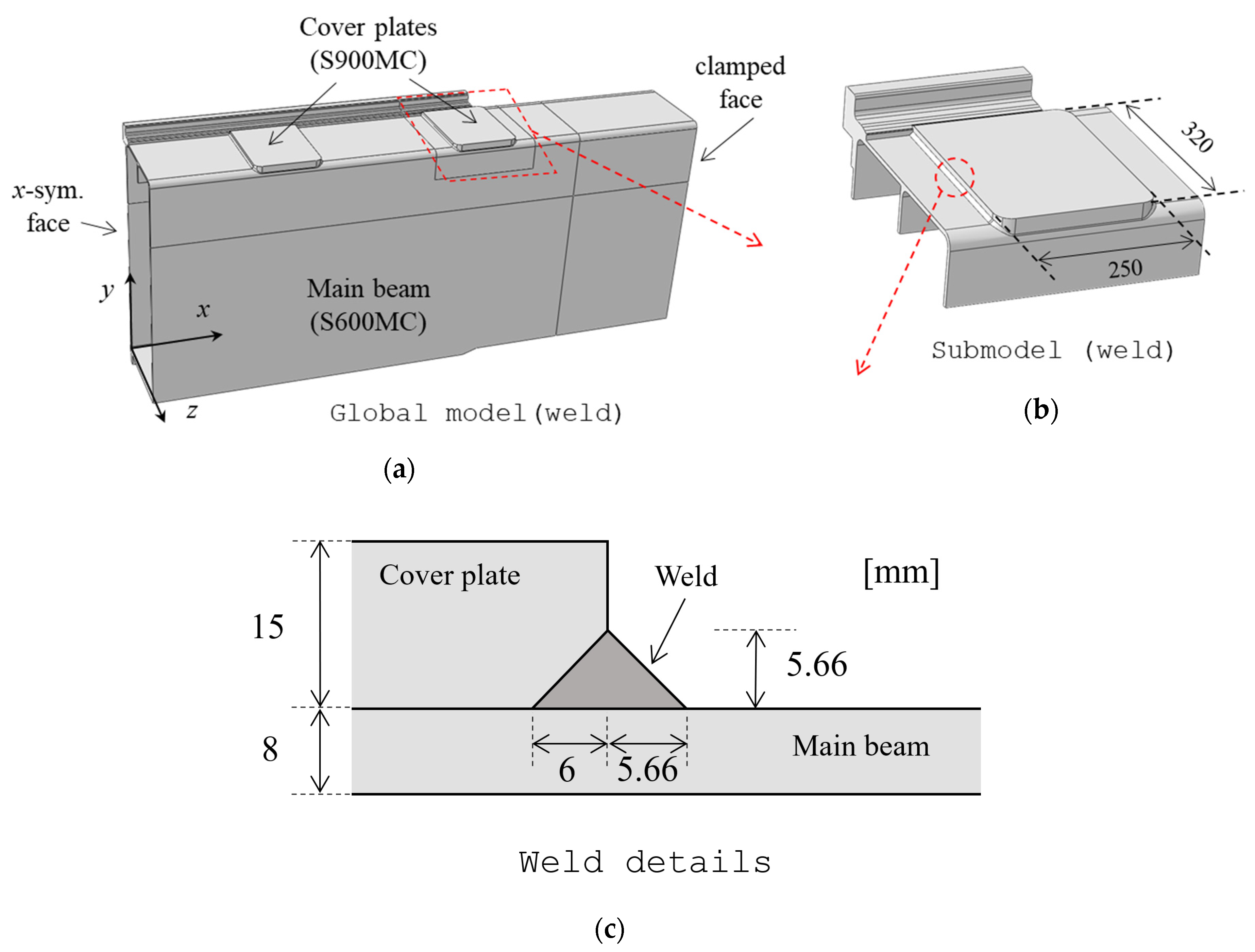
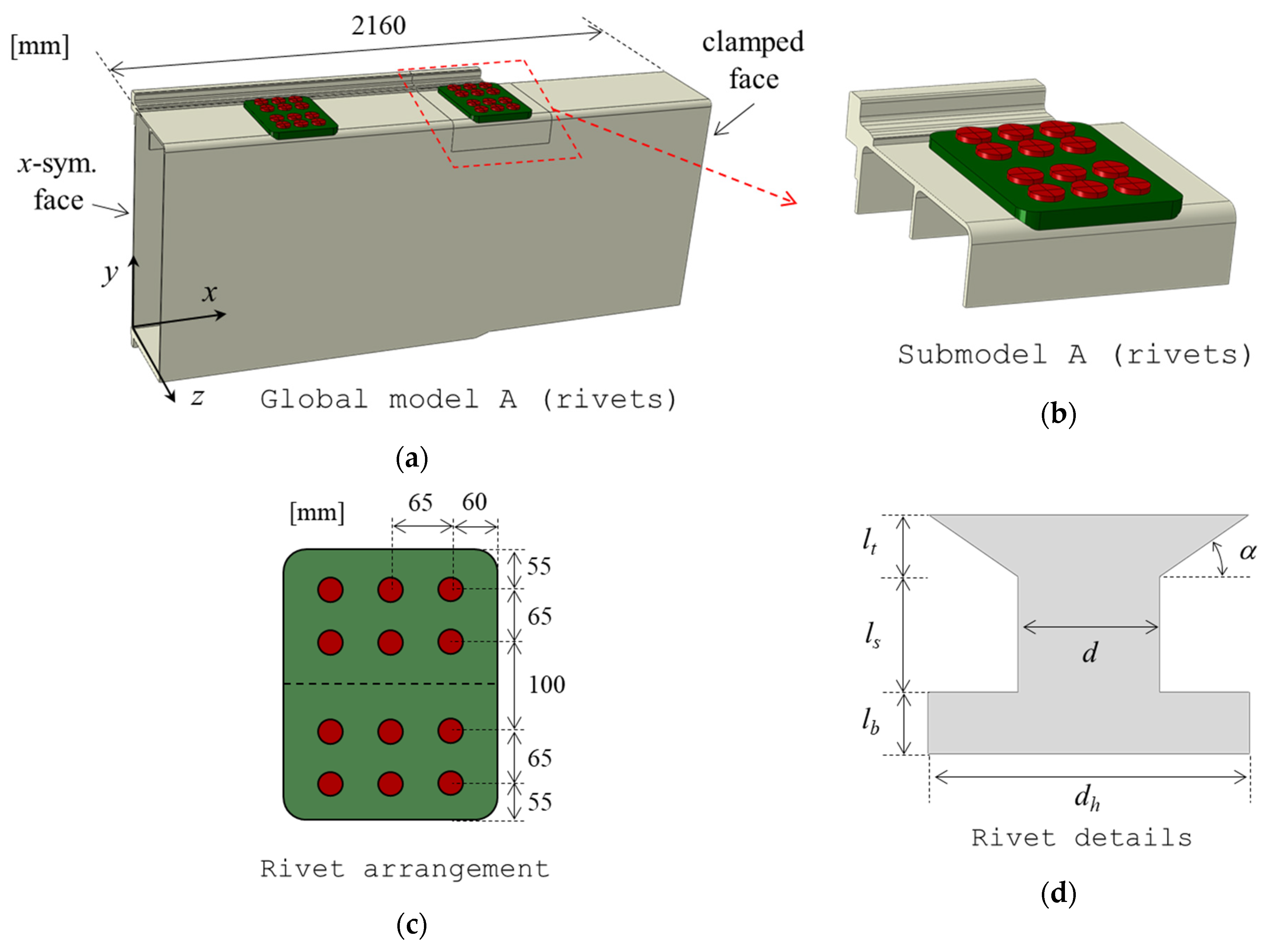
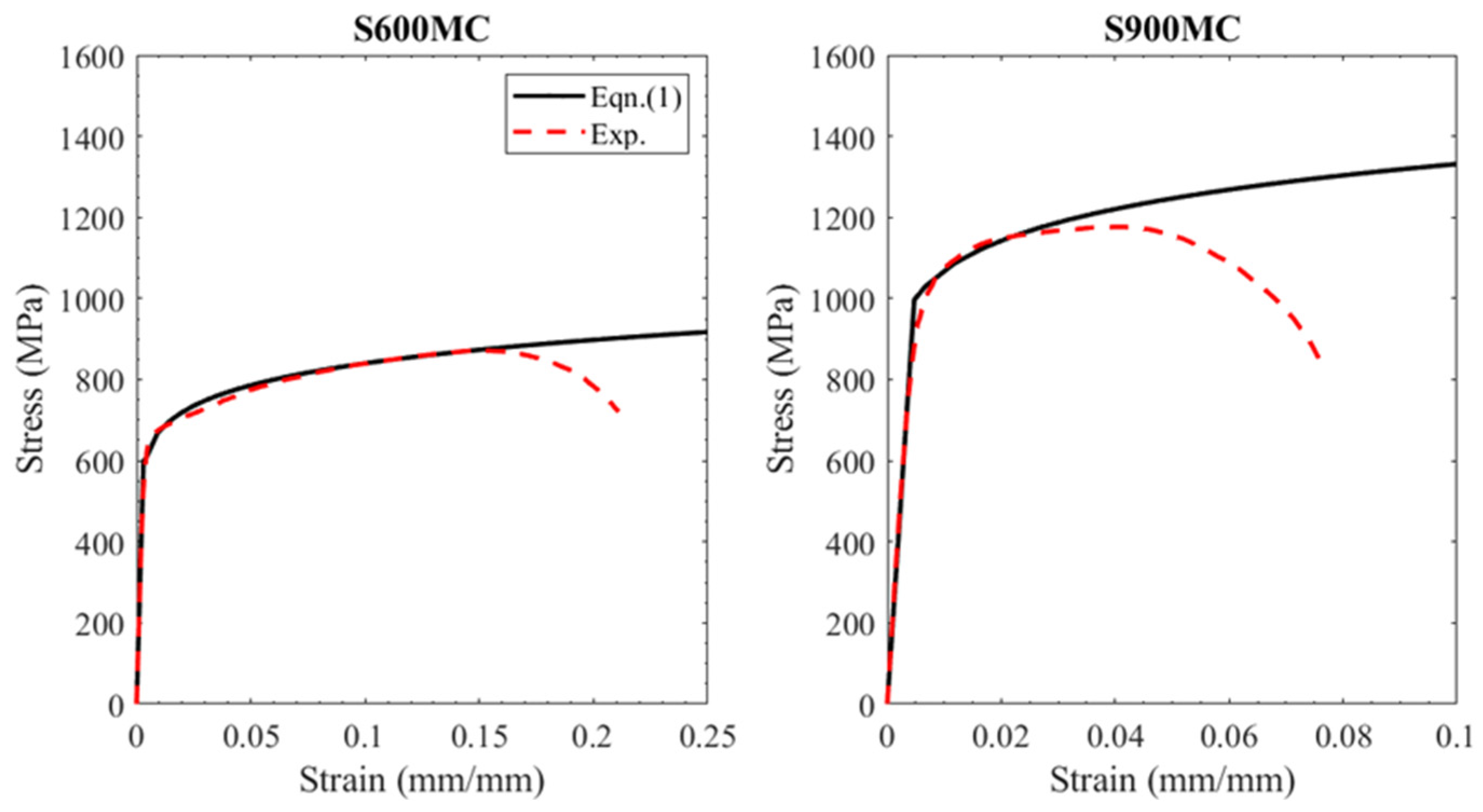


| Specimen Number | Specimen from [27] | c (-) | d (mm) | t (mm) | w (mm) | r (mm) | p (mm) | n (-) |
|---|---|---|---|---|---|---|---|---|
| SN-1 | S-16-10-1 | Symmetric | 16 | 10 | 70 | 35 | - | 1 |
| SN-2 | U-16-10-1 | Unsymmetric | 16 | 10 | 70 | 35 | - | 1 |
| SN-3 | S-19-10-1 | Symmetric | 19 | 10 | 90 | 45 | - | 1 |
| SN-4 | U-19-10-1 | Unsymmetric | 19 | 10 | 90 | 45 | - | 1 |
| SN-5 | U-19-12-1 | Unsymmetric | 19 | 12 | 90 | 45 | - | 1 |
| SN-6 | S-22-12-1 | Symmetric | 22 | 12 | 70 | 35 | - | 1 |
| SN-7 | S-19-10-2 | Symmetric | 19 | 10 | 90 | 45 | 120 | 2 |
| SN-8 | U-22-12-2 | Unsymmetric | 22 | 12 | 70 | 35 | 90 | 2 |
| SN-9 | S-22-12-4 | Symmetric | 22 | 12 | 70 | 35 | 90 | 4 |
| Plate No. | (MPa) | (-) | (mm/mm) | (mm/mm) | (MPa) | (mm/mm) |
| 1 | 303 | 0.208 | 0.008 | 0.012 | 523 | 0.17 |
| 2 | 294 | 0.214 | 0.008 | 0.012 | 514 | 0.17 |
| 3 | 302 | 0.217 | 0.008 | 0.014 | 509 | 0.17 |
| 4 | 302 | 0.216 | 0.008 | 0.014 | 510 | 0.17 |
| Average | 300 | 0.214 | 0.008 | 0.013 | 514 | 0.17 |
| Std. Dev. (±) | 4 | 0.003 | 0 | 0.001 | 6 | 0 |
| Rivet No. | (MPa) | (-) | (mm/mm) | (mm/mm) | (MPa) | (mm/mm) |
| 1 | 271 | 0.160 | 0.000 | 0.006 | 478 | 0.18 |
| 2 | 308 | 0.245 | 0.008 | 0.020 | 500 | 0.13 |
| 3 | 316 | 0.180 | 0.008 | 0.020 | 471 | 0.16 |
| 4 | 335 | 0.116 | 0.008 | 0.010 | 438 | 0.13 |
| 5 | 325 | 0.150 | 0.008 | 0.005 | 495 | 0.09 |
| 6 | 352 | 0.085 | 0.000 | 0.002 | 471 | 0.06 |
| 7 | 343 | 0.114 | 0.008 | 0.004 | 515 | 0.14 |
| 8 | 347 | 0.118 | 0.008 | 0.011 | 474 | 0.10 |
| 9 | 325 | 0.187 | 0.008 | 0.023 | 479 | 0.20 |
| Average | 325 | 0.151 | 0.007 | 0.011 | 480 | 0.13 |
| Std. Dev. (±) | 23 | 0.046 | 0.003 | 0.008 | 21 | 0.04 |
| Case | Analysis (1) | Fe (kN) | δe (mm) | Fu (kN) | δu (mm) | δmax (mm) | Fmax (kN) | Failure Mode |
|---|---|---|---|---|---|---|---|---|
| SN-1 | Experiment A | 107.01 | 0.39 | 146.08 | 5.51 | 7.00 | 116.86 | Shear failure of rivet |
| Experiment B | 109.22 | 0.43 | 147.99 | 6.26 | 7.59 | 118.39 | ||
| Experiment C | 90.06 | 0.35 | 131.43 | 3.90 | 5.34 | 105.14 | ||
| Simulation | 109.29 | 0.12 | 143.66 | 5.10 | 6.29 | 114.93 | Shear failure of rivet | |
| SN-2 | Experiment A | 66.94 | 0.41 | 80.02 | 2.50 | 3.39 | 64.02 | Shear failure of rivet |
| Experiment B | 64.41 | 0.42 | 83.95 | 3.83 | 4.36 | 67.16 | ||
| Experiment C | 62.30 | 0.45 | 76.71 | 3.06 | 3.91 | 61.39 | ||
| Simulation | 66.29 | 0.34 | 79.92 | 3.02 | 4.22 | 63.94 | Shear failure of rivet | |
| SN-3 | Experiment A | 136.01 | 0.46 | 180.45 | 5.80 | 11.17 | 144.36 | Bearing of plate at rivet hole |
| Experiment B | 141.70 | 0.46 | 232.35 | 12.08 | 14.80 | 185.88 | ||
| Experiment C | 130.02 | 0.53 | 207.12 | 10.10 | 11.40 | 165.70 | ||
| Simulation | 152.64 | 0.14 | 204.83 | 10.39 | 11.59 | 163.86 | Bearing of plate at rivet hole | |
| SN-4 | Experiment A | 47.36 | 0.43 | 86.99 | 3.04 | 3.85 | 69.59 | Shear failure of rivet |
| Experiment B | 95.34 | 0.46 | 108.93 | 2.85 | 3.68 | 87.14 | ||
| Experiment C | 64.00 | 0.47 | 108.52 | 5.12 | 6.04 | 86.82 | ||
| Simulation | 88.03 | 0.34 | 107.70 | 3.09 | 4.33 | 86.16 | Shear failure of rivet | |
| SN-5 | Experiment A | 60.07 | 0.41 | 100.63 | 3.65 | 4.15 | 80.50 | Shear failure of rivet |
| Experiment B | 87.37 | 0.61 | 145.28 | 5.55 | 6.57 | 116.22 | ||
| Experiment C | 73.36 | 0.80 | 106.84 | 3.81 | 4.72 | 85.47 | ||
| Simulation | 87.64 | 0.30 | 107.23 | 2.87 | 4.07 | 85.78 | Shear failure of rivet | |
| SN-6 | Experiment A | 156.72 | 0.48 | 236.18 | 4.32 | 6.11 | 188.94 | Bearing of plate at rivet hole |
| Experiment B | 153.36 | 0.56 | 238.23 | 6.02 | 10.05 | 190.58 | ||
| Simulation | 155.64 | 0.18 | 207.66 | 8.10 | 9.97 | 166.13 | Bearing of plate at rivet hole | |
| SN-7 | Experiment A | 236.69 | 0.84 | 336.63 | 14.24 | 16.80 | 269.30 | Tearing of plate net section |
| Experiment B | 240.71 | 0.60 | 346.02 | 16.27 | 18.75 | 276.82 | ||
| Experiment C | 230.69 | 0.63 | 332.60 | 10.46 | 13.45 | 266.08 | ||
| Simulation | 268.47 | 0.38 | 371.89 | 12.66 | 14.56 | 297.51 | Tearing of plate net section | |
| SN-8 | Experiment A | 170.02 | 1.60 | 279.05 | 10.46 | 11.63 | 223.24 | Tearing of plate net section |
| Experiment B | 184.03 | 1.63 | 255.24 | 8.88 | 10.13 | 204.19 | ||
| Experiment C | 170.72 | 1.64 | 280.77 | 11.60 | 13.49 | 224.62 | ||
| Simulation | 236.87 | 2.82 | 285.03 | 12.43 | 12.63 | 228.02 | Tearing of plate net section | |
| SN-9 | Experiment A | 249.26 | 0.75 | 308.94 | 9.76 | 12.17 | 247.15 | Tearing of plate net section |
| Experiment B | 250.06 | 0.85 | 298.54 | 9.76 | 12.00 | 238.83 | ||
| Experiment C | 247.68 | 0.66 | 303.50 | 7.24 | 8.95 | 242.80 | ||
| Simulation | 296.25 | 1.59 | 306.35 | 6.96 | 8.72 | 245.08 | Tearing of plate net section |
| Steel Grade | (MPa) | (-) | (mm/mm) |
|---|---|---|---|
| S600MC | 600 | 0.096 | 0.130 |
| S900MC | 997 | 0.095 | 0.016 |
Disclaimer/Publisher’s Note: The statements, opinions and data contained in all publications are solely those of the individual author(s) and contributor(s) and not of MDPI and/or the editor(s). MDPI and/or the editor(s) disclaim responsibility for any injury to people or property resulting from any ideas, methods, instructions or products referred to in the content. |
© 2023 by the authors. Licensee MDPI, Basel, Switzerland. This article is an open access article distributed under the terms and conditions of the Creative Commons Attribution (CC BY) license (https://creativecommons.org/licenses/by/4.0/).
Share and Cite
Lundkvist, A.; Barsoum, I.; Barsoum, Z.; Khurshid, M. Geometric and Material Modelling Aspects for Strength Prediction of Riveted Joints. Metals 2023, 13, 500. https://doi.org/10.3390/met13030500
Lundkvist A, Barsoum I, Barsoum Z, Khurshid M. Geometric and Material Modelling Aspects for Strength Prediction of Riveted Joints. Metals. 2023; 13(3):500. https://doi.org/10.3390/met13030500
Chicago/Turabian StyleLundkvist, Axel, Imad Barsoum, Zuheir Barsoum, and Mansoor Khurshid. 2023. "Geometric and Material Modelling Aspects for Strength Prediction of Riveted Joints" Metals 13, no. 3: 500. https://doi.org/10.3390/met13030500





